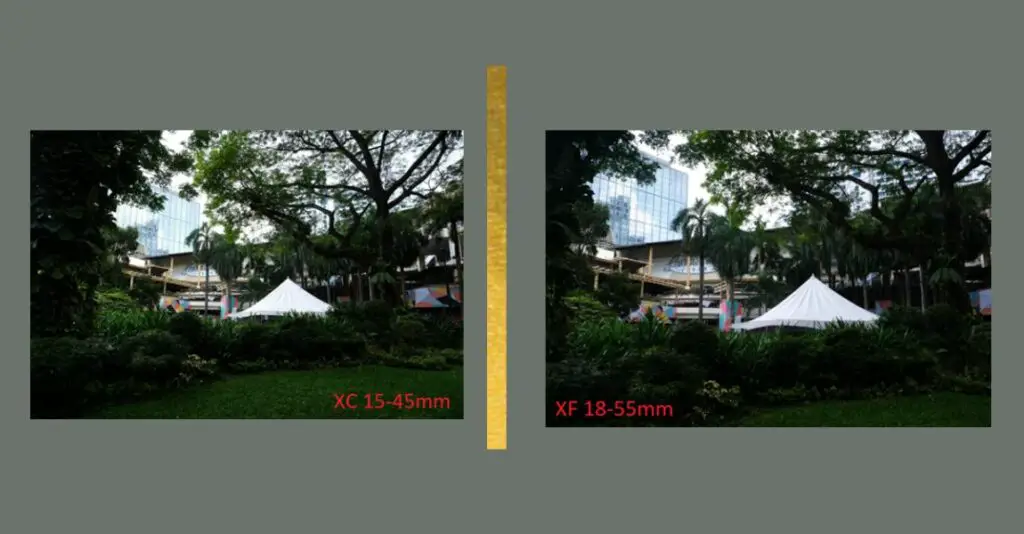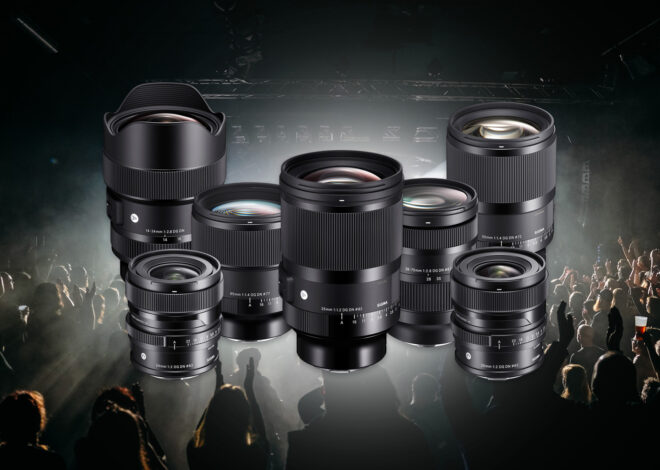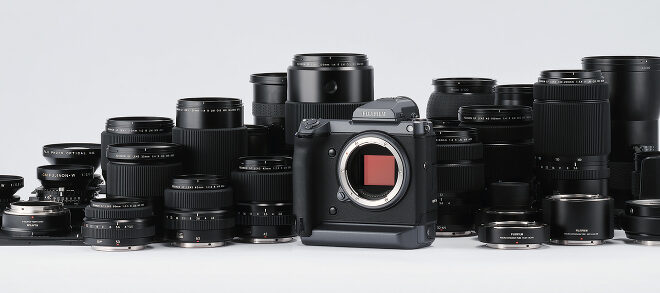
XC 15-45mm vs XF 18-55mm: What are The Differences?
As an Amazon Associate, I earn from qualifying purchases.
Fujifilm has a wide variety of kit lenses to choose from for a new photographer. Kit lenses are a staple item for someone wanting to get into the photography scene.
Whether it be casual photography or professional work having a short lens to start with is always easier than scouring through the big fish in the market.
XF and XC are Fujifilm’s two different lineups of kit lenses that come paired with a camera. XC is the more budget-friendly lineup whereas the XF lineup is geared toward a more premium feel.
In this article, I’ll be taking a look at xc 15-45mm and xf 18-55mm and give a recommendation based on both lenses’ performance.
XC 15-45mm vs XF 18-55mm: Quick Comparison Table
| Features | xc 15-45mm | xf 18-55mm |
| Mount | Fuji X | Fuji X |
| Focal range | 15-45mm | 18-55mm |
| Aperture Range | F3.5-5.6 | F2.8-4.0 |
| Maximum Magnification | 0.24x | 0.15x |
| Weather Sealed | No | No |
| Min. Focus Distance | 0.13m | 0.4m |
| Filter Thread | 52mm | 58mm |
| Length | 44mm | 70mm |
| Weight | 136g | 310g |
| Price | $299 | $699 |
| Buy here | Fujinon XC15-45mm | Fujinon XF18-55mm |
Comparison of Features: XC 15-45mm vs XF 18-55mm
Time to look at the key differences between the two lenses and why they might be of consideration.
Price:
In buying anything new, price is the first consideration for most people. These lenses come at differing price points. There is a $400 difference between the two lenses.
The Fujifilm XF 18-55mm comes at a staggering price of $699. You can get better lenses for this price. The $400 premium isn’t just for show though. Fujifilm has built this piece very carefully to make it more durable and functional in the long run.
The Fujifilm XC 15-45mm is priced at $299 only. This is the optimal price point for a kit lens. Kit lenses are starter lenses in nature. So paying the extra for a similar focal range would not be wise.
The Fujifilm XC 15-45mm gets a point and takes the lead here based on price only.
Design and Build Quality:
There is a big difference in the build quality of the lenses. To make the XC 15-45mm as cheap as it is, they had to cut some corners during the manufacturing process.
The XF 18-55mm’s body is built with metal. It feels more premium and robust in the hand. The lens hood is also metal built which adds to the overall build of the lens.
The XC 15-45mm comes with an all-plastic body. The hood is also plastic and it feels cheap in the hands. This is where most of the cost reduction was done on Fujifilm’s part.
Here is a side-by-side image of both lenses.

The XF 18-55mm has a built-in aperture ring for ease of changing the aperture on the lens. Buttons on the lens include an OIS on/off and an Aperture mode button to turn the auto aperture on and off.
The XC 15-45mm only consists of the basic zoom ring and the focus ring and there are no additional buttons. It doesn’t include an aperture ring either.
In terms of functionality and user-friendliness, the XF 18-55mm lens is the superior one.
Size and Weight:
The XC 15-45mm only weighs about 136g. It is a very light lens. Holding the lens mounted on a camera feels the same as having the lens unmounted. It is comparatively shorter as well. The lens is only 44mm in length when not extended.
The Fujifilm XF 19-55mm’s weight is about 310g. The lens is 70mm in length. It is heavier and longer than the XC 15-45mm. Having a longer lens can sometimes pose problems if the user has a smaller bag for carrying the camera and the lens.
The XC 15-45mm takes another point here.
Performance:
This is the most important criterion in choosing a lens. Price does play a big role but the most crucial aspect is how a lens performs in real-life shooting scenarios.
Shorter kit lenses are mostly used for wide-angle shots such as landscapes and close-up portraits. Hence, the main comparison of performance will be at 15mm for the XC 15-45mm and 18mm for the XF 18-55mm which is the shortest focal length for each lens.
Here are the images.

As the images above show, the XC 15-45mm has a wider angle of view compared to the XF 18-55mm lens. The frames capture more of the scenario which is essential for landscapes.
However, the XF 18-55mm beats the XC 15-45mm in terms of sharpness and overall image quality. The details are more noticeable in the image taken with the XF 18-55mm lens. But the difference isn’t night and sky.
The XC 15-45mm produces brighter images and more distinct highlights and shadows whereas the XF 18-55mm falls short. For the price difference, the XC 15-45mm keeps up just fine.
Although the XF 18-55mm delivers better image quality, the XC 15-45 mm takes the win here for its better price-to-performance ratio.
Low Light Capabilities:
The XF 18-55mm does a great job in low-light scenarios. This lens delivers better low light performance and a more shallow depth of field.
The XC 15-45mm will only work for casual vlogging and at-home setups with artificial lights helping the lens get better results.
However, this can be mitigated somewhat at ISO 3200. The XF 18-55mm produced overexposed images and video shots but the XC 15-45mm held up quite nicely.
Although the point goes to the Fujifilm XF 18-55mm for better low light performance, it does not take the win per se.
Image Stabilization
The XF 18-55mm takes the obvious win here since it has OIS. It can’t be stressed enough that it has a $400 price premium.
XC 15-45mm vs XF 18-55mm: Which one is the best?
Both lenses are very good on their own. The XF 18-55mm is a fantastic lens that performs slightly better than the XC 15-45mm but has way better functionality and ease of use. So, if budget is not the issue, then it can be a good choice as a starter kit.
But the overall win goes to the XC 15-45mm for its better price-to-performance ratio. As a kit lens, it performs as expected within a price range that doesn’t break the bank.
User Feedbacks
The Fujinon XC 15-45mm lens has overall great reviews. From being cheap in comparison to its XF counterparts to delivering similar performance to them.
Most users bought this lens because they wanted a cheap wide focal length alternative but were later found surprised by how sharp the photos come out.
Users have been hesitant to get this lens for its plastic build. Another user has stated that the lens is a complete dud and not worth the buy because it has too much barrel distortion. This creates a loose connection between the camera and the lens.
On the other hand, people who bought the Fujinon XF 18-55mm were all satisfied with the performance but some of them complained about the high price.
Even for a high-price lens, users have given this lens outstanding reviews. One user said the price is ‘ok’ because the lens comes with a sturdy build and takes amazing pictures.
Another user has complained that the zoom was a bit loose and the overlay box wasn’t very accurate. But the sharpness and autofocus were very accurate with great image stabilization technology. They also stated that the price was reasonable.
Frequently Asked Questions (FAQs)
What’s the difference between XC and XF lenses?
The main difference is that the XF lenses are more premium and catered towards being more robust and durable with a metal-built body and hood.
The XC lineup on the other hand is built as budget oriented and has plastic bodies and hoods.
What is the sharpest Fujifilm lens?
Fujifilm XF 90mm f2.
The lens excels in every aspect from bokeh, and fast focus to subject separation and overall performance.
Is weather sealing important for lenses?
It is an important aspect.
Having weather sealing in a lens can help it endure splashes and dust. A non-weather sealed lens won’t be of much use when paired with a weather-sealed camera as it won’t be able to function under those circumstances.
Summary
There are alternatives to the XF 18-55mm at its price range that performs way better and has a long focal range. At that price point, you’re better off buying something like the Fujinon XF 16-80mm F4 or the Tamron 17-70mm F/2.8 Di III-A RDX
The Fujinon XC 15-45mm will easily fulfill all of your daily photography needs. It is wholeheartedly recommended for purchase.
I hope this article helps you make the right decision about your starter kit or wide-angle lens.
- Read Also: Which Lenses are Best for Hasselblad 500C/M in 2023?
- Read Also: Which Lenses Pro Clickers Should You Use For Fuji GFX 100?
- Read Also: Sigma 150-600mm Contemporary with 1.4x Teleconverter?
- Read Also: Canon rf 100-500 vs Sony 200-600: The Super Zoom Lens Debate
- Read Also: 150mm vs 200mm Lens: The Different Focal Lengths and Their Use Scenarios



